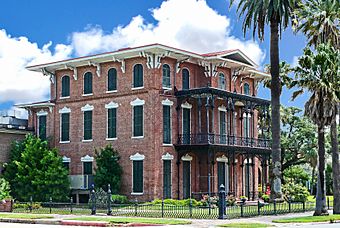Ashton Villa facts for kids
|
Ashton Villa
|
|

Ashton Villa in 2012
|
|
| Location | 2328 Broadway St., Galveston, Texas |
|---|---|
| Area | 0.5 acres (0.20 ha) |
| Built | 1858 |
| Architect | James Moreau Brown |
| Architectural style | Victorian, Italianate |
| NRHP reference No. | 69000204 |
Quick facts for kids Significant dates |
|
| Added to NRHP | October 28, 1969 |
Ashton Villa is a beautiful old house in Galveston, Texas. It stands proudly at the corner of 24th and Broadway. Built in 1859, it was one of the first brick buildings in Texas. People who were forced to work without pay helped build this important home.
Contents
A Look Inside Ashton Villa
Building a Historic Home
In 1859, a rich merchant and banker named Colonel James Moreau Brown bought the land for Ashton Villa. He used ideas from architecture books to design his dream home. People who were forced to work without pay, along with skilled workers from Europe, helped build it. This made it one of the first brick buildings in Texas.
The house has three stories and was built in the Victorian Italianate style. This means it has deep roof edges, long windows, and fancy porches. The brick walls are very thick, about 13 inches. This helped protect the house from humidity and made it very strong. Inside, the rooms are set up around a main hallway. Brown's wife, Rebecca Ashton, named the house after one of her ancestors. This ancestor was Lt. Isaac Ashton, a hero in the American Revolutionary War.
Ashton Villa During the Civil War
When the American Civil War started in 1861, Ashton Villa became a very important place. It was used as the main office for the Confederate Army throughout most of the war.
For a short time in 1862, the Union Army took control of Galveston. They also used Ashton Villa as their headquarters. But the Union's stay was brief. In January 1863, the Confederates took Galveston back during the Battle of Galveston. Ashton Villa then went back to being a Confederate headquarters.
The End of the War and Freedom Day
The Civil War officially ended on April 9, 1865. However, news traveled slowly to far-off states like Texas. More than a month after the official surrender, the Battle of Palmito Ranch was fought in Texas. This battle happened on May 12 and 13, 1865. It took about two more weeks for the Confederate general in charge of Texas to surrender.
On June 19, 1865, Union Major General Gordon Granger arrived in Galveston, Texas. He came with 2,000 federal troops. Their job was to take control of Texas and make sure all enslaved people were freed. This was part of the Emancipation Proclamation, a special order from the President.
General Granger's soldiers marched through Galveston. They read an important message called General Order No. 3. This order told everyone in Texas that all enslaved people were now free. It said that formerly enslaved people would have the same rights as everyone else. They were advised to stay in their homes and work for pay.
What is Juneteenth?
June 19 has become known as Juneteenth. This name combines "June" and "nineteenth." It is a special day to remember when freedom finally reached Texas.
After General Granger's announcement, formerly enslaved people in Galveston celebrated in the streets. Juneteenth celebrations began in Texas the next year. Across Texas, freed people bought land for their communities to hold large Juneteenth gatherings. Famous examples include Emancipation Park in Houston and Emancipation Park in Austin.
Today, a statue of Al Edwards stands on the grounds of Ashton Villa. Edwards was a state representative who helped make Juneteenth a paid holiday in Texas in 1979. Every Juneteenth, a special prayer breakfast and celebration are held at Ashton Villa. During this event, a historian often plays the role of Major General Granger. They read the Emancipation Proclamation and General Order No. 3 from the home's balcony.
Surviving the Great Storm
Colonel Brown, who built Ashton Villa, passed away in 1895. This was just five years before the terrible Galveston Hurricane of 1900 hit the city. But the house, with its super thick brick walls, was very strong. It managed to survive the storm's powerful winds and huge waves. Brown's widow and children found shelter inside the house during the storm.
After the storm, the city of Galveston was raised higher to protect it from future floods. The basement of Ashton Villa was filled with sand. The ground around the house was covered with two feet of new soil.
Ashton Villa Today
In 1927, a group called the El Mina Shrine bought the home. They used it as their offices and meeting place until 1970. At that time, the house was put up for sale. It was in danger of being torn down.
Luckily, the Galveston Historical Foundation stepped in. They raised money to buy Ashton Villa. With more help from other groups and the government, they began to fix up and refurnish the historic house. They even found much of the original furniture and art.
On July 25, 1974, the Galveston Historical Foundation opened Ashton Villa to the public. It became a museum where visitors could learn about its history. It also served as a visitor center and a place for special events.
In 2008, Hurricane Ike caused the first floor to flood with over 18 inches of water. The house was restored again after that. Ashton Villa is not currently open for public tours. However, its first floor can be rented for private events.
Ashton Villa is recognized as a very important historical site. It is listed on the National Register of Historic Places. It is also a Recorded Texas Historic Landmark.
More to Explore




